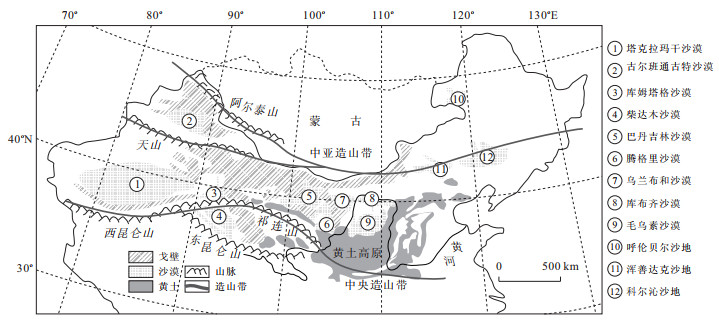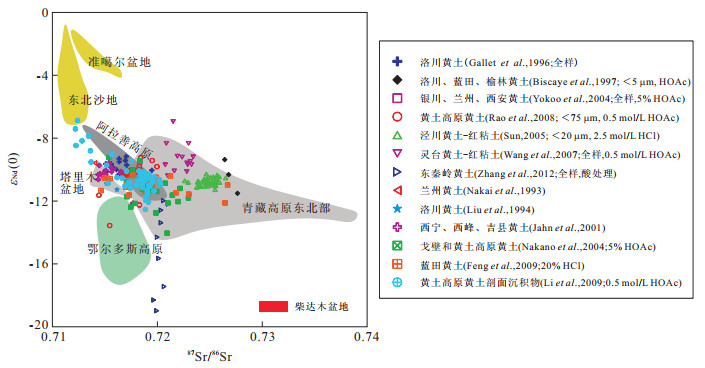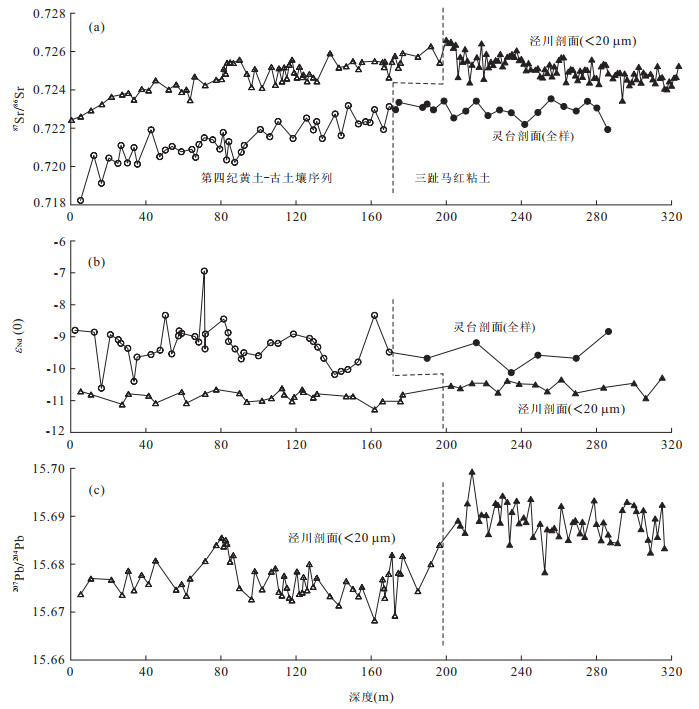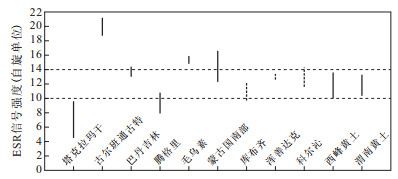Progress in Tracing Provenance of Eolian Deposits in Chinese Loess Plateau
-
摘要: 黄土高原风尘堆积是开展古环境变化研究的重要沉积物,其源区的具体位置和变化程度对于揭示东亚大气环流演化具有关键意义,而且一直被学术界广泛关注,存在较大争议.前人通过地球化学(Sr-Nd-Pb同位素、元素地球化学、碎屑锆石U-Pb年龄)、矿物学(白云石、重矿物)、物理学(释光灵敏度、电子自旋共振信号和环境磁学)、气象观测与模拟、地貌学等方法对黄土高原风尘堆积及其潜在源区(北方荒漠和戈壁以及青藏高原东北部)开展了大量示踪研究.研究表明青藏高原东北部、阿拉善高原、塔里木盆地和蒙古戈壁可能是非常重要的源区.目前存在的问题:(1)源区的具体区位;(2)源区物质供给系统是否存在时空变化;(3)第四纪以来的黄土研究居多,而更老时间尺度上风尘堆积的物源研究较少.因此,今后开展更多粉尘物源示踪方法学的研究,并加强第四纪以前黄土高原风尘堆积的物源研究,是风尘堆积物源研究的重要内容.Abstract: Eolian deposits accumulated in the Chinese Loess Plateau (CLP) are valuable archive for reconstruction of paleoenvironmental change in East Asia. The source area of the eolian deposits in the CLP is correlated with the evolution of past atmospheric circulation of East Asia, so it is highly focused by researchers. However, the controversies are still being debated. During the past, methods of geochemistry (isotope geochemistry, element geochemistry, and detrital zircon U-Pb age), mineralogy (dolomite, heavy mineral composition), optically stimulated luminescence (OSL) sensitivity, electronic spine resonance (ESR) signal intensity, environmental magnetism, meteorological observation and modeling, and geomorphic methods were applied to track the source area of the eolian deposits by comparative study of the sediments in the CLP and the potential source areas (e.g., gobi and deserts in north China and the northeast Qinghai-Tibet Plateau) surrounding the CLP. The results show that the source area of eolian deposits in the CLP lies in the north and northwest of the CLP, and northeast Qinghai-Tibet Plateau, the Alashan Plateau (Badan Jaran desert, Tengger desert), Tarim basin and Mongolia would be the most important source areas. The controversies mostly focus on which detail area can be the source area of the eolian deposits in the CLP and whether the source area changed temporarily and spatially. Recent provenance studies of the eolian deposits in the CLP are mainly concentrated on the Quaternary loess deposits, but the studies of older deposits are relatively few. Thus, more methodologies of tracing the source area of eolian deposits and more studies for provenance of eolian deposits which accumulated before Quaternary would be the main task in the future.
-
Key words:
- Chinese Loess Plateau /
- eolian deposit /
- provenance /
- desert /
- Qinghai-Tibet Plateau /
- geochemistry
-
图 1 黄土高原与北方戈壁、荒漠(据Sun,2002和Chen et al., 2007修改)
Fig. 1. Chinese Loess Plateau, gobi and deserts in North China
图 2 黄土高原风尘堆积与潜在源区的Sr-Nd同位素组成
潜在源区阿拉善高原、鄂尔多斯高原、塔里木盆地、柴达木盆地、准噶尔盆地和东北沙地的数据来自Chen et al., 2007;青藏高原东北部的数据来自Yang et al., 2009和Li et al., 2011
Fig. 2. Sr-Nd isotope composition of the eolian deposits in northern China and their possible source areas
图 3 泾川、灵台剖面风尘堆积Sr、Nd和Pb同位素比值的演化
a和b.数据来自Sun,2005和Wang et al., 2007;c.数据来自Sun and Zhu, 2010
Fig. 3. Sr, Nd and Pb isotopic ratios of eolian deposits in the Jingchuan and Lingtai sections
图 4 风尘物质中不同粒级组分中Sr、Nd和Pb同位素比值
样品L10、L33、L1、S5和红粘土数据依据Rao et al., 2006;样品LT-25、ZT-2和WJ-1数据依据Feng et al., 2009;样品LH1-3的Pb同位素比值据Feng et al., 2010
Fig. 4. Sr, Nd and Pb isotopic compositions of eolian deposits in different grain-size components
图 6 西峰和渭南晚第四纪黄土与潜在源区石英颗粒(<16 μm)的ESR信号强度(据Sun et al., 2007, 2008)
Fig. 6. Electronic spin resonance (ESR) signal intensity of quartz grain (< 16 μm) in sediments at Xifeng and Weinan sections and possible source areas of the eolian deposit
表 1 黄土高原风尘堆积主要源区研究结果
Table 1. The source areas of the eolian deposits in Chinese Loess Plateau
阿拉善高原a 青藏高原 鄂尔多斯高原b 塔里木盆地 柴达木盆地 准噶尔盆地 参考文献 √ Bowler et al., 1987 √ Liu et al., 1994 √ √ × Sun et al., 2001 √ √ × × × Sun,2002 √ √ Zhang et al., 2003 √ Fang et al., 2004 √ Honda et al., 2004 √ √ √ Rao et al., 2006 √ × √ Chen et al., 2007 √ √ √ Li et al., 2007 × √ 李锋,2007 √ √ 杨杰东等,2007 √ Rao et al., 2008 √ √ × Sun et al., 2008 √ Yang and Ding, 2008 √ √ √ Yang et al., 2009 √ √ Jeong and Lee, 2010 √ √ Stevens et al., 2010 √ Ferrat et al., 2011 √ Kapp et al., 2011 √ √ Pullen et al., 2011 √:是风尘堆积的主要源区;×:不是风尘堆积的主要源区; a.阿拉善高原:包括巴丹吉林沙漠、腾格里沙漠和乌兰布和沙漠; b.鄂尔多斯高原:包括库布齐沙漠和毛乌素沙漠. -
An, Z.S., Kutzbach, J.E., Prell, W.L., et al., 2001. Evolution of Asian Monsoons and Phased Uplift of the Himalaya-Tibetan Plateau since Late Miocene Times. Nature, 411: 62-66. doi: 10.1038/35075035 Asahara, Y., Tanaka, T., Kamioka, H., et al., 1995. Asian Continental Nature of 87Sr/86Sr Ratios in North Central Pacific Sediments. Earth and Planetary Science Letters, 133(1-2): 105-116. doi: 10.1016/0012-821X(95)00048-H Asahara, Y., Tanaka, T., Kamioka, H., et al., 1999. Provenance of the North Pacific Sediments and Process of Source Material Transport as Derived from Rb-Sr Isotopic Systematics. Chemical Geology, 158(3-4): 271-291. doi: 10.1016/S0009-2541(99)00056-X Belousova, E., Griffin, W., O'Reilly, S.Y., et al., 2002. Igneous Zircon: Trace Element Composition as an Indicator of Source Rock Type. Contributions to Mineralogy and Petrology, 143(5): 602-622. doi: 10.1007/s00410-002-0364-7 Bhatia, M.R., Crook, K.A.W., 1986. Trace Element Characteristics of Graywackes and Tectonic Setting Discrimination of Sedimentary Basins. Contributions to Mineralogy and Petrology, 92(2): 181-193. doi: 10.1007/BF00375292 Biscaye, P.E., Grousset, F.E., Revel, M., et al., 1997. Asian Provenance of Glacial Dust (Stage 2) in the Greenland Ice Sheet Project 2 Ice Core, Summit, Greenland. Journal of Geophysical Research, 102(C12): 26751-26781. doi: 10.1029/97JC01249 Bowler, J.M., Chen, K.Z., Yuan, B.Y., 1987. Systematic Variations in Loess Source Areas: Evidence from Qaidam and Qinghai Basins, Western China. In: Liu, T.S., ed., Aspects of Loess Research. China Ocean Press, Beijing, 39-51. Chen, H.Y., Sun, Y.B., 2008. Study on Provenance of Eolian Dust Deposits on the Chinese Loess Plateau: Retrospects and Prospects. Quaternary Sciences, 28(5): 892-900(in Chinese with English abstract). http://d.wanfangdata.com.cn/Periodical_dsjyj200805012.aspx Chen, J., 2012. Progress of Aeolian Sediments and Dust Geochemistry in Asia in the New Century. Bulletin of Mineralogy, Petrology and Geochemistry, 31(5): 433-446(in Chinese with English abstract). http://en.cnki.com.cn/Article_en/CJFDTOTAL-KYDH201205003.htm Chen, J., Li, G.J., 2011. Geochemical Studies on the Source Region of Asian Dust. Sci. China: Earth Sci. , 54(9): 1279-1301. doi: 10.1007/s11430-011-4269-z Chen, J., Li, G.J., Yang, J.D., et al., 2007. Nd and Sr Isotopic Characteristics of Chinese Deserts: Implications for the Provenances of Asian Dust. Geochimica et Cosmochimica Acta, 71(15): 3904-3914. doi: 10.1016/j.gca.2007.04.033 Cheng, Y., Zhang, X.Y., Lu, H.Y., et al., 2003. Variations of Elemental Geochemistry in Chinese Loess during the Last 140 ka BP and Their Paleoclimatological Implications. Marine Geology & Quaternary Geology, 23(3): 103-108(in Chinese with English abstract). http://en.cnki.com.cn/Article_en/CJFDTOTAL-HYDZ200303016.htm Ding, Z.L., Derbyshire, E., Yang, S.L., et al., 2002. Stacked 2.6 Ma Grain Size Record from the Chinese Loess Based on Five Sections and Correlation with the Deep-Sea δ18O Record. Paleoceanography, 17(3). doi: 10.1029/2001PA000725 Ding, Z.L., Xiong, S.F., Sun, J.M., et al., 1999. Pedostratigraphy and Paleomagnetism of a ~7.0 Ma Eolian Loess-Red Clay Sequence at Lingtai, Loess Plateau, North-Central China and the Implications for Paleomonsoon Evolution. Palaeogeography, Palaeoclimatology, Palaeoecology, 152: 49-66. doi: 10.1016/S0031-0182(99)00034-6 Fang, X.M., Han, Y.X., Ma, J.H., et al., 2004. Dust Storms and Loess Accumulation on the Tibetan Plateau: A Case Study of Dust Event on 4 March 2003 in Lhasa. Chinese Science Bulletin, 49(9): 953-960. doi: 10.1007/BF03184018 Faure, G., 1998. Isotope Geochronology and Its Applications to Geology. Earth Science Frontiers, 5(1-2): 17-40. http://en.cnki.com.cn/Article_en/CJFDTOTAL-DXQY801.003.htm Feng, J.L., Hu, Z.G., Cui, J.Y., et al., 2010. Distributions of Lead Isotopes with Grain Size in Aeolian Deposits. Terra Nova, 22(4): 257-263. doi: 10.1111/j.1365-3121.2010.00941.x Feng, J.L., Zhu, L.P., Zhen, X.L., et al., 2009. Grain Size Effect on Sr and Nd Isotopic Compositions in Eolian Dust: Implications for Tracing Dust Provenance and Nd Model Age. Geochemical Journal, 43: 123-131. doi: 10.2343/geochemj.1.0007 Ferrat, M., Weiss, D.J., Strekopytov, S., et al., 2011. Improved Provenance Tracing of Asian Dust Sources Using Rare Earth Elements and Selected Trace Elements for Palaeomonsoon Studies on the Eastern Tibetan Plateau. Geochimica et Cosmochimica Acta, 75(21): 6374-6399. doi: 10.1016/j.gca.2011.08.025 Gallet, S., Jahn, B., Torii, M., 1996. Geochemical Characterization of the Luochuan Loess-Paleosol Sequence, China, and Paleoclimatic Implications. Chemical Geology, 133: 67-88. doi: 10.1016/S0009-2541(96)00070-8 Gallet, S., Jahn, B., van Vliet Lano, B., et al., 1998. Loess Geochemistry and Its Implications for Particle Origin and Composition of the Upper Continental Crust. Earth and Planetary Science Letters, 156: 157-172. doi: 10.1016/S0012-821X(97)00218-5 Ge, J.Y., Guo, Z.T., Zhan, T., et al., 2012. Magnetostratigraphy of the Xihe Loess-Soil Sequence and Implication for Late Neogene Deformation of the West Qinling Mountains. Geophysical Journal International, 189(3): 1399-1408. doi: 10.1111/j.1365-246X.2012.05461.x Guo, Z.T., Ruddiman, W.F., Hao, Q.Z., et al., 2002. Onset of Asian Desertification by 22 Myr Ago Inferred from Loess Deposits in China. Nature, 416: 159-163. doi: 10.1038/416159a Guo, Z.T., Sun, B., Zhang, Z.S., et al., 2008. A Major Reorganization of Asian Climate by the Early Miocene. Climate of the Past, 4: 153-174. doi: 10.5194/cp-4-153-2008 Hao, Q.Z., Guo, Z.T., 2004. Magnetostratigraphy of a Late Miocene-Pliocene Loess-Soil Sequence in the Western Loess Plateau in China. Geophysical Research Letters, 31: L09209. doi: 10.1029/2003GL019392 Hao, Q.Z., Guo, Z.T., 2007. Magnetostratigraphy of an Early-Middle Miocene Loess-Soil Sequence in the Western Loess Plateau of China. Geophysical Research Letters, 34: L18305. doi: 10.1029/2007GL031162 Hao, Q.Z., Guo, Z.T., Qiao, Y.S., et al., 2010. Geochemical Evidence for the Provenance of Middle Pleistocene Loess Deposits in Southern China. Quaternary Science Reviews, 29: 3317-3326. doi: 10.1016/j.quascirev.2010.08.004 Hao, Q.Z., Wang, L., Oldfield, F., et al., 2012. Delayed Build-up of Arctic Ice Sheets during 400 000-Year Minima in Insolation Variability. Nature, 490: 393-396. doi: 10.1038/nature11493 Heller, F., Liu, T.S., 1982. Magnetostratigraphical Dating of Loess Deposits in China. Nature, 300: 431-433. doi: 10.1038/300431a0 Honda, M., Yabuki, S., Shimizu, H., 2004. Geochemical and Isotopic Studies of Aeolian Sediments in China. Sedimentology, 51(2): 211-230. doi: 10.1111/j.1365-3091.2004.00618.x Jahn, B., Gallet, S., Han, J., 2001. Geochemistry of the Xining, Xifeng and Jixian Sections, Loess Plateau of China: Eolian Dust Provenance and Paleosol Evolution during the Last 140 ka. Chemical Geology, 178: 71-94. doi: 10.1016/S0009-2541(00)00430-7 Jeong, G.Y., Lee, K.S., 2010. A Mineral Tracer toward High-Resolution Dust Provenance on the Chinese Loess Plateau: SEM, TEM, and Sulfur Isotopes of Sulfate Inclusions in Biotite. American Mineralogist, 95(1): 64-72. doi: 10.2138/am.2010.3234 Kapp, P., Pelletier, J.D., Rohrmann, A., et al., 2011. Wind Erosion in the Qaidam Basin, Central Asia: Implications for Tectonics, Paleoclimate, and the Source of the Loess Plateau. GSA Today, 21: 4-10. doi: 10.1130/GSATG99A.1 Lai, Z.P., Wintle, A.G., 2006. Locating the Boundary between the Pleistocene and the Holocene in Chinese Loess Using Luminescence. The Holocene, 16(6): 893-899. doi: 10.1191/0959683606hol980rr Lee, J.K.W., Williams, I.S., Ellis, D.J., 1997. Pb, U and Th Diffusion in Natural Zircon. Nature, 390: 159-162. doi: 10.1038/36554 Li, F., 2007. Distribution Characteristics of Lead Isotope in Dust Source Areas and Its Trace Significance in the North of China. Journal of Desert Research, 27(5): 738-744(in Chinese with English abstract). http://en.cnki.com.cn/Article_en/CJFDTOTAL-ZGSS200705004.htm Li, G.J., 2010. Trace the Source Regions of East Asia Dust Using Geochemical Tools (Dissertation). Nanjing University, Nanjing(in Chinese with English abstract). Li, G.J., Chen, J., Chen, Y., et al., 2007. Dolomite as a Tracer for the Source Regions of Asian Dust. Journal of Geophysical Research, 112: D17201. doi: 10.1029/2007JD008676 Li, G.J., Chen, J., Ji, J.F., et al., 2009. Natural and Anthropogenic Sources of East Asian Dust. Geology, 37(8): 727-730. doi: 10.1130/G30031A.1 Li, G.J., Pettke, T., Chen, J., 2011. Increasing Nd Isotopic Ratio of Asian Dust Indicates Progressive Uplift of the North Tibetan Plateau since the Middle Miocene. Geology, 39(3): 199-202. doi: 10.1130/G31734.1 Liang, M.Y., 2009. Geochemical Characteristics of the Miocene Eolian Deposits in Northern China: Their Provenance and Climatic Implications (Dissertation). Graduate University of Chinese Academy of Sciences, Beijing(in Chinese with English abstract). Liang, M.Y., Guo, Z.T., Kahmann, A.J., et al., 2009. Geochemical Characteristics of the Miocene Eolian Deposits in China: Their Provenance and Climate Implications. Geochemistry Geophysics Geosystems, 10: Q04004. doi: 10.1029/2008GC002331 Liu, C.Q., Masuda, A., Okada, A., et al., 1993. A Geochemical Study of Loess and Desert Sand in Northern China: Implications for Continental Crust Weathering and Composition. Chemical Geology, 106: 359-374. doi: 10.1016/0009-2541(93)90037-J Liu, C.Q., Masuda, A., Okada, A., et al., 1994. Isotope Geochemistry of Quaternary Deposits from the Arid Lands in Northern China. Earth and Planetary Science Letters, 127: 25-38. doi: 10.1016/0012-821X(94)90195-3 Liu, D.S., 1985. Loess and Environment. Science Press, Beijing (in Chinese). Liu, L.W., Wang, H.T., Chen, J., 2006. Reconstruction of the Rainfall on the Chinese Loess Plateau during the Past 130 ka from the Dolomite Distributions. Geochimica et Cosmochimica Acta, 70(18): A363. doi: 10.1016/j.gca.2006.06.735 Liu, L.W., Wang, H.T., Cheng, Y., et al., 2002. Chemical Leaching of Loess Deposits in China and Its Implications for Carbonate Composition. Acta Petrologica et Mineralogica, 21(1): 69-73(in Chinese with English abstract). http://www.researchgate.net/publication/285464872_Chemical_leaching_of_loess_deposits_in_China_and_its_implications_for_carbonate_composition Lu, H.Y., Wang, X.Y., An, Z.S., et al., 2004. Geomorphologic Evidence of Phased Uplift of the Northeastern Qinghai-Tibet Plateau since 14 Million Years Ago. Science in China (Series D), 47(9): 822-833. doi: 10.1360/03yd0315 Lü, T.Y., Sun, J.M., 2011. Luminescence Sensitivities of Quartz Grains from Eolian Deposits in Northern China and Their Implications for Provenance. Quaternary Research, 76(2): 181-189. doi: 10.1016/j.yqres.2011.06.015 Maher, B.A., Mutch, T.J., Cunningham, D., 2009. Magnetic and Geochemical Characteristics of Gobi Desert Surface Sediments: Implications for Provenance of the Chinese Loess Plateau. Geology, 37(3): 279-282. doi: 10.1130/g25293a.1 Maher, B.A., Prospero, J.M., Mackie, D., et al., 2010. Global Connections between Aeolian Dust, Climate and Ocean Biogeochemistry at the Present Day and at the Last Glacial Maximum. Earth-Science Reviews, 99: 61-97. doi: 10.1016/j.earscirev.2009.12.001 McLennan, S.M., Hemming, S., McDaniel, D.K., et al., 1993. Geochemical Approaches to Sedimentation, Provenance, and Tectonics. Geological Society of America Special Paper, 284: 21-40. doi: 10.1130/spe284-p21 Nakai, S., Halliday, A.N., Rea, D.K., 1993. Provenance of Dust in the Pacific Ocean. Earth and Planetary Science Letters, 119(1-2): 143-157. doi: 10.1016/0012-821X(93)90012-X Nakano, T., Yokoo, Y., Nishikawa, M., et al., 2004. Regional Sr-Nd Isotopic Ratios of Soil Minerals in Northern China as Asian Dust Fingerprints. Atmospheric Environment, 38(19): 3061-3067. doi: 10.1016/j.atmosenv.2004.02.016 Ono, Y., Naruse, T., Ikeya, M., et al., 1998. Origin and Derived Courses of Eolian Dust Quartz Deposited during Marine Isotope Stage 2 in East Asia, Suggested by ESR Signal Intensity. Global and Planetary Change, 18(3): 129-135. doi: 10.1016/S0921-8181(98)00012-5 Pullen, A., Kapp, P., McCallister, A.T., et al., 2011. Qaidam Basin and Northern Tibetan Plateau as Dust Sources for the Chinese Loess Plateau and Paleoclimatic Implications. Geology, 39(11): 1031-1034. doi: 10.1130/G32296.1 Qiang, X.K., An, Z.S., Song, Y.G., et al., 2011. New Eolian Red Clay Sequence on the Western Chinese Loess Plateau Linked to Onset of Asian Desertification about 25 Ma Ago. Sci. China: Earth Sci. , 54(1): 136-144. doi: 10.1007/s11430-010-4126-5 Qin, X.G., Ning, B., Yin, Z.Q., et al., 2011. Evolution of Soil Organic Carbon Pool in Weinan Loess Region since the Last Interglacial Period. Earth Science—Journal of China University of Geosciences, 36(2): 386-392(in Chinese with English abstract). doi: 10.3799/dqkx.2011.043 Quade, J., Roe, L., DeCelles, P.G., et al., 1997. The Late Neogene 87Sr/86Sr Record of Lowland Himalayan Rivers. Science, 276(5320): 1828-1831. doi: 10.1126/science.276.5320.1828 Rao, W.B., Chen, J., Yang, J.D., et al., 2008. Sr-Nd Isotopic Characteristics of Eolian Deposits in the Erdos Desert and Chinese Loess Plateau: Implications for Their Provenances. Geochemical Journal, 42(3): 493-506. http://www.researchgate.net/publication/280293917_Sr-Nd_isotopic_characteristics_of_eolian_deposits_in_the_Erdos_Desert_and_Chinese_Loess_Plateau_Implications_for_their_provenances Rao, W.B., Yang, J.D., Chen, J., et al., 2006. Sr-Nd Isotope Geochemistry of Eolian Dust of the Arid-Semiarid Areas in China: Implications for Loess Provenance and Monsoon Evolution. Chinese Science Bulletin, 51(12): 1401-1412. doi: 10.1007/s11434-006-2008-1 Ridgwell, A.J., 2002. Dust in the Earth System: The Biogeochemical Linking of Land, Air and Sea. Philosophical Transactions of the Royal Society A, 360(1801): 2905-2924. doi: 10.1098/rsta.2002.1096 Sheldon, N.D., Tabor, N.J., 2009. Quantitative Paleoenvironmental and Paleoclimatic Reconstruction Using Paleosols. Earth-Science Reviews, 95: 1-52. doi: 10.1016/j.earscirev.2009.03.004 Shi, Z.G., Liu, X.D., 2011. Distinguishing the Provenance of Fine-Grained Eolian Dust over the Chinese Loess Plateau from a Modelling Perspective. Tellus, 63(5): 959-970. doi: 10.1111/j.1600-0889.2011.00561.x Stevens, T., Carter, A., Watson, T.P., et al., 2013. Genetic Linkage between the Yellow River, the Mu Us Desert and the Chinese Loess Plateau. Quaternary Science Reviews, 78: 355-368. doi: 10.1016/j.quascirev.2012.11.032 Stevens, T., Palk, C., Carter, A., et al., 2010. Assessing the Provenance of Loess and Desert Sediments in Northern China Using U-Pb Dating and Morphology of Detrital Zircons. Geological Society of America Bulletin, 122(7-8): 1331-1344. doi: 10.1130/B30102.1 Sun, B., 2006. A Preliminary Study on Magnetostratigraphy and Sedimentology of the Miocene Eolian Deposit in Gaojiazhuang, Center-South of Gansu (Dissertation). Graduate University of Chinese Academy of Sciences, Beijing(in Chinese with English abstract). Sun, J.M., 2002. Provenance of Loess Material and Formation of Loess Deposits on the Chinese Loess Plateau. Earth and Planetary Science Letters, 203: 845-859. doi: 10.1016/S0012-821X(02)00921-4 Sun, J.M., 2005. Nd and Sr Isotopic Variations in Chinese Eolian Deposits during the Past 8 Ma: Implications for Provenance Change. Earth and Planetary Science Letters, 240(2): 454-466. doi: 10.1016/j.epsl.2005.09.019 Sun, J.M., Zhang, M.Y., Liu, T.S., 2001. Spatial and Temporal Characteristics of Dust Storms in China and Its Surrounding Regions, 1960-1999: Relations to Source Area and Climate. Journal of Geophysical Research, 106(D10): 10325-10333. doi: 10.1029/2000JD900665 Sun, J.M., Zhu, X.K., 2010. Temporal Variations in Pb Isotopes and Trace Element Concentrations within Chinese Eolian Deposits during the Past 8 Ma: Implications for Provenance Change. Earth and Planetary Science Letters, 290: 438-447. doi: 10.1016/j.epsl.2010.01.001 Sun, Y.B., Tada, R., Chen, J., et al., 2007. Distinguishing the Sources of Asian Dust Based on Electron Spin Resonance Signal Intensity and Crystallinity of Quartz. Atmospheric Environment, 41(38): 8537-8548. doi: 10.1016/j.atmosenv.2007.07.014 Sun, Y.B., Tada, R., Chen, J., et al., 2008. Tracing the Provenance of Fine-Grained Dust Deposited on the Central Chinese Loess Plateau. Geophysical Research Letters, 35: L01804. doi: 10.1029/2007GL031672 Taylor, S.R., McLennan, S.M., McCulloch, M.T., 1983. Geochemistry of Loess, Continental Crustal Composition and Crustal Model Ages. Geochimica et Cosmochimica Acta, 47(11): 1897-1905. doi: 10.1016/0016-7037(83)90206-5 Wang, H.B., Yu, Y.P., Liu, X.B., et al., 2011. Geochemical Characteristics of Last Interglacial Paleosols in the Chinese Loess Plateau and Its Implications to Loess Provenance. Quaternary Sciences, 31(2): 338-346(in Chinese with English abstract). doi: 10.3969/j.issn.1001-7410.2011.02.16 Wang, Y.X., Yang, J.D., Chen, J., et al., 2007. The Sr and Nd Isotopic Variations of the Chinese Loess Plateau during the Past 7 Ma: Implications for the East Asian Winter Monsoon and Source Areas of Loess. Palaeogeography, Palaeoclimatology, Palaeoecology, 249: 351-361. doi: 10.1016/j.palaeo.2007.02.010 Wu, F., Ho, S.S.H., Sun, Q.L., et al., 2011. Provenance of Chinese Loess: Evidence from Stable Lead Isotope. Terrestrial Atmospheric and Oceanic Sciences, 22(3): 305-314. doi: 10.3319/tao.2010.11.19.01(TT) Wu, W.H., Xu, S.J., Yang, J., et al., 2009. Sr Fluxes and Isotopic Compositions in the Headwaters of the Yangtze River, Tongtian River and Jinsha River Originating from the Qinghai-Tibet Plateau. Chemical Geology, 260: 63-72. doi: 10.1016/j.chemgeo.2008.12.007 Xiao, G.Q., Zong, K.Q., Li, G.J., et al., 2012. Spatial and Glacial-Interglacial Variations in Provenance of the Chinese Loess Plateau. Geophysical Research Letters, 39: L20715. doi: 10.1029/2012GL053304 Xie, J., 2007. Tracing the Provenance of the Eastern China Sandlands and Its Geological Significance (Dissertation). Graduate University of Chinese Academy of Sciences, Beijing(in Chinese with English abstract). Xie, J., Ding, Z.L., 2007. Compositions of Heavy Minerals in Northeastern China Sandlands and Provenance Analysis. Science in China (Series D), 50(11): 1715-1723. doi: 10.1007/s11430-007-0110-0 Xie, J., Wu, F.Y., Ding, Z.L., 2007. Detrital Zircon Composition of U-Pb Ages and Hf Isotope of the Hunshandake Sandland and Implication for Its Provenance. Acta Petrologica Sinica, 23(2): 523-528(in Chinese with English abstract). http://www.researchgate.net/publication/285892621_Detrital_zircon_composition_of_U-Pb_ages_and_Hf_isotope_of_the_Hunshandake_sandland_and_implications_for_its_provenance Yang, J.D., Chen, J., An, Z.S., et al., 2000. Variations in 87Sr/86Sr Ratios of Calcites in Chinese Loess: A Proxy for Chemical Weathering Associated with the East Asian Summer Monsoon. Palaeogeography, Palaeoclimatology, Palaeoecology, 157(1): 151-159. doi: 10.1016/S0031-0182(99)00159-5 Yang, J.D., Chen, J., Rao, W.B., et al., 2007. Isotopic Partition Characteristics of Chinese Deserts. Geochimica, 36(5): 516-524(in Chinese with English abstract). http://www.sciencedirect.com/science/article/pii/S0016703707002207 Yang, J.D., Li, G.J., Rao, W.B., et al., 2009. Isotopic Evidences for Provenance of East Asian Dust. Atmospheric Environment, 43(29): 4481-4490. doi: 10.1016/j.atmosenv.2009.06.035 Yang, S.L., Ding, Z.L., 2008. Advance-Retreat History of the East-Asian Summer Monsoon Rainfall Belt over Northern China during the Last Two Glacial-Interglacial Cycles. Earth and Planetary Science Letters, 274: 499-510. doi: 10.1016/j.epsl.2008.08.001 Yang, S.Y., Jiang, S.Y., Ling, H.F., et al., 2007. Sr-Nd Isotopic Compositions of the Changjiang Sediments: Implications for Tracing Sediment Sources. Science in China(Ser. D), 50(10): 1556-1565. doi: 10.1007/s11430-007-0052-6 Yokoo, Y., Nakano, T., Nishikawa, M., et al., 2004. Mineralogical Variation of Sr-Nd Isotopic and Elemental Compositions in Loess and Desert Sand from the Central Loess Plateau in China as a Provenance Tracer of Wet and Dry Deposition in the Northwestern Pacific. Chemical Geology, 204: 45-62. doi: 10.1016/j.chemgeo.2003.11.004 Zeng, F.M., 2011. Provenances of the Different Cenozoic Deposits in the Tianshui-Qinan Regions (Dissertation). Graduate University of Chinese Academy of Sciences, Beijing(in Chinese with English abstract). Zeng, F.M., Xiang, S.Y., Lu, Y.L., et al., 2007. Environmental Evolution of Late Pleistocene Loess Deposits at Lintao County, Gansu Province. Earth Science—Journal of China University of Geosciences, 32(5): 703-712(in Chinese with English abstract). Zeng, F.M., Xiang, S.Y., Zhang, K.X., et al., 2011. Environmental Evolution Recorded by Lipid Biomarkers from the Tawan Loess-Paleosol Sequences on the West Chinese Loess Plateau during the Late Pleistocene. Environmental Earth Sciences, 64(7): 1951-1963. doi: 10.1007/s12665-011-1012-1 Zhan, T., Guo, Z.T., Wu, H.B., et al., 2011. Thick Miocene Eolian Deposits on the Huajialing Mountains: The Geomorphic Evolution of the Western Loess Plateau. Sci. China: Earth Sci. , 54(2): 241-248. doi: 10.1007/s11430-010-4051-7 Zhang, H.Y., Lu, H.Y., Jiang, S.Y., et al., 2012. Provenance of Loess Deposits in the Eastern Qinling Mountains (Central China) and Their Implications for the Paleoenvironment. Quaternary Science Reviews, 43: 94-102. doi: 10.1016/j.quascirev.2012.04.010 Zhang, X.Y., 2007. Review on Sources and Transport of Loess Materials on the Chinese Loess Plateau. Quaternary Sciences, 27(2): 181-186(in Chinese with English abstract). http://www.cnki.com.cn/Article/CJFDTotal-DSJJ200702002.htm Zhang, X.Y., Gong, S.L., Zhao, T.L., et al., 2003. Sources of Asian Dust and Role of Climate Change versus Desertification in Asian Dust Emission. Geophysical Research Letters, 30(24): 2272. doi: 10.1029/2003gl018206 Zheng, C.X., Zhou, L.P., 2012. Further Investigations of Quartz Luminescence Signals as a Tool for Dust Source Tracing. Quaternary Sciences, 32(5): 1036-1045(in Chinese with English abstract). doi: 10.3969/j.issn.1001-7410.2012.05.19 陈洪云, 孙有斌, 2008. 黄土高原风尘沉积的物质来源研究: 回顾与展望. 第四纪研究, 28(5): 892-900. doi: 10.3321/j.issn:1001-7410.2008.05.012 陈骏, 2012. 新世纪亚洲风尘系统地球化学研究进展. 矿物岩石地球化学通报, 31(5): 433-446. doi: 10.3969/j.issn.1007-2802.2012.05.003 程燕, 张小曳, 鹿化煜, 等, 2003. 最近140 ka以来黄土元素地球化学演化及其古气候意义. 海洋地质与第四纪地质, 23(3): 103-108. https://www.cnki.com.cn/Article/CJFDTOTAL-HYDZ200303016.htm 李锋, 2007. 中国北方沙尘源区铅同位素分布特征及其示踪意义的初步研究. 中国沙漠, 27(5): 738-744. https://www.cnki.com.cn/Article/CJFDTOTAL-ZGSS200705004.htm 李高军, 2010. 东亚风尘物源地球化学示踪研究(博士学位论文). 南京: 南京大学. 梁美艳, 2009. 中国北方中新世风尘物质来源及古气候的地球化学指示(博士学位论文). 北京: 中国科学院研究生院. 刘东生, 1985. 黄土与环境. 北京: 科学出版社. 刘连文, 王洪涛, 陈旸, 等, 2002. 黄土醋酸淋溶实验及其碳酸盐组分的地球化学特征. 岩石矿物学杂志, 21(1): 69-73. doi: 10.3969/j.issn.1000-6524.2002.01.009 秦小光, 宁波, 殷志强, 等, 2011. 末次间冰期以来渭南黄土地区土壤有机碳碳库的演变. 地球科学——中国地质大学学报, 36(2): 386-392. https://www.cnki.com.cn/Article/CJFDTOTAL-DQKX201102028.htm 孙斌, 2006. 甘肃中南部高家庄中新世风尘堆积磁性地层和沉积学特征的初步研究(硕士学位论文). 北京: 中国科学院研究生院. 汪海斌, 于英鹏, 刘现彬, 等, 2011. 黄土高原S1古土壤的地球化学特征及其对物源的指示. 第四纪研究, 31(2): 338-346. doi: 10.3969/j.issn.1001-7410.2011.02.16 谢静, 2007. 中国东部沙地物源示踪及地质意义(博士学位论文). 北京: 中国科学院研究生院. 谢静, 吴福元, 丁仲礼, 2007. 浑善达克沙地的碎屑锆石U-Pb年龄和Hf同位素组成及其源区意义. 岩石学报, 23(2): 523-528. https://www.cnki.com.cn/Article/CJFDTOTAL-YSXB200702029.htm 杨杰东, 陈骏, 饶文波, 等, 2007. 中国沙漠的同位素分区特征. 地球化学, 36(5): 516-524. doi: 10.3321/j.issn:0379-1726.2007.05.010 曾方明, 2011. 甘肃天水-秦安地区新生代沉积物物源示踪研究(博士学位论文). 北京: 中国科学院研究生院. 曾方明, 向树元, 路玉林, 等, 2007. 甘肃临洮晚更新世黄土环境变迁. 地球科学——中国地质大学学报, 32(5): 703-712. https://www.cnki.com.cn/Article/CJFDTOTAL-DQKX200705015.htm 张小曳, 2007. 有关中国黄土高原黄土物质的源区及其输送方式的再评述. 第四纪研究, 27(2): 181-186. doi: 10.3321/j.issn:1001-7410.2007.02.003 郑辰鑫, 周力平, 2012. 石英释光信号作为粉尘物源示踪手段的再研究. 第四纪研究, 32(5): 1036-1045. doi: 10.3969/j.issn.1001-7410.2012.05.19 -










 下载:
下载:






